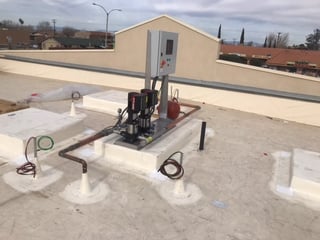With the cost of floor space on the rise, building owners are moving pumps outside — including to the roof of the building — to utilize every square inch of precious real estate.
If this is you, it's important to consider environmental factors that affect the install of outdoor pump covers on a rooftop. In addition to planning for inclement weather and theft prevention, you also need to plan for the wind.
Secure Your Pump Cover
Wind is commonly overlooked during the planning process, and it can have serious consequences if not handled correctly.
For example, we received a request to cover a pump skid on the top of a multi-story building on the west coast. Typical winds in this region can reach gusts of 25+ miles per hour at ground level and will increase as you move higher. The last thing you want is for the wind to pick up the enclosure that's covering the pump skids and equipment. This rogue enclosure could damage surrounding buildings, or worse, injure a person.
To keep this from happening, we recommend our outdoor pump covers be attached to concrete pads using the provided mounting brackets and concrete anchor bolts. These materials have been tested to withstand wind gusts of up to 130 mph.
Know Your Roof
It's also important to consider the roof details. Building rooftops are typically constructed of a few different types of materials such as metal or EPDM (rubber roofing membrane). The roofing system might use multiple layers of materials that are eventually covered with gravel.Most building owners don't want you poking holes in their roof so as not to void its warranty.
So, how should you mount an enclosure on a rooftop?
The best solution is securing outdoor pump covers to something heavy, like a metal skid or a piece of flat steel, that will keep everything in its place. We've also seen contractors utilize a concrete slab on top of the roof, though this is less common due to the weight of the concrete. We do not suggest anchoring the enclosure to a wooden platform.
Lock it Up
After you know how to mount your enclosure in place, you need to think about the door design. Doors are needed to provide access to the pumps and control panels for maintenance throughout the year.
How do you keep enclosure doors from swinging open during high winds and bad weather?
Hinges are commonly used in this situation. Hinges can be placed along the doors to keep them in place while pumps and equipment are worked on. Plus, hinges secure doors to the enclosure while in the closed position.
Our enclosure doors have built-in foldable t-handles to lock them in place. You may also want to consider installing hasps on the outside of the enclosure doors as an extra precaution, in case someone forgets to fully engage the t-handles or you're located in a highly wind prone area.
It's best to reach out to us as early as possible in the planning process. That way we can help mitigate potential issues, keep the project on schedule and keep everyone safe.
Ventilation Options for Pump Covers on the Roof
When selecting a pump enclosure, ventilation is a critical feature that protects the integrity and functionality of your units. Heat buildup can quickly reduce the lifespan of equipment, making it essential to choose the ideal ventilation setup: fans, louvers or a combination of both.
Proper ventilation supports long-term performance by regulating interior temperature and preventing overheating of enclosed units. That’s especially important on rooftops, where direct sun exposure can intensify heat issues. We offer a range of ventilation options, so the cover product you purchase can be tailored to your specific environment and equipment needs.
-
Louvers provide passive ventilation, allowing hot air to escape while keeping out debris and water.
-
Powered fans can actively cool the interior, making them a smart add-on for more extreme climates or sensitive equipment.
Safe-T-Cover provides both functional options to match the size, layout and thermal requirements of your enclosure.
Whether your units require minimal air flow or robust cooling support, selecting the right ventilation solution contributes to equipment reliability, lowers maintenance costs and ensures your enclosure is sized appropriately for performance, not just protection.
Need help designing your pump cover? Check out our free guide.




